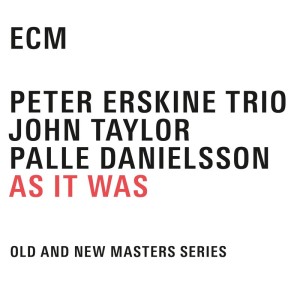 This wonderful set reprises the rich legacy of the Peter Erskine Trio’s four albums for ECM between 1993 and 1999. It’s four hours of music that covers nearly all the bases of contemporary piano trio possibilities, from sublime ballads and melodic post-bop, to a bit of swing plus lots of abstract contemporary works.
This wonderful set reprises the rich legacy of the Peter Erskine Trio’s four albums for ECM between 1993 and 1999. It’s four hours of music that covers nearly all the bases of contemporary piano trio possibilities, from sublime ballads and melodic post-bop, to a bit of swing plus lots of abstract contemporary works.
It’s an oddity to find a piano trio led by a drummer, but New Jersey-born Peter Erskine created this one with British pianist John Taylor and Swedish bassist Palle Danielsson. Taylor, who died in 2015, was the trio’s main composer, although both Erskine and Danielsson tossed an occasional tune into the mix, and they also covered tunes by the likes of Vince Mendoza and especially Kenny Wheeler, with whom all three of this trio’s members played on some key dates and tours. Erskine also played in both the Maynard Ferguson and Stan Kenton big bands and on the other end of the spectrum the electric jazz group Weather Report.
The unexpected passing of Taylor last year prompted the reissue of these four albums under ECM’s “New & Old Masters” imprint. The albums are You Never Know (1993), Time Being (1994), As It Is (1996) and Juni (1999). In general they progress from the most traditional and melodic You Never Know to the most abstract Juni, which reflected the direction Taylor was moving as a composer and arranger. But there is ample variety throughout and on each disc.
It would be hard to find a better opener for an album or a box set than the nine-minute “New Old Age” that starts You Never Know. The first full minute-and-a-half is piano solo before Danielsson’s bass enters with four subtle whole notes and Erskine an even subtler cymbal wash. It’s a fitting introduction to this trio’s ethos, the continual push-pull of tension between rhythm and melody, both of which flow fluidly among the three players. It’s an intriguing piece with an extraordinarily creative arrangement.
You Never Know‘s other bookend is the only standard the trio recorded, Cole Porter’s “Everything I Love.” Bill Evans was an early influence on Taylor, and that influence comes through some on this piece, oddly moreso than on Taylor’s tune “Evans Above.” Speaking of covers, one of the prettiest tracks is Erskine’s “On The Lake.” Something kept nagging at my ears as I heard this one’s simple repeated two-note melodic motif, but I didn’t figure out what it was until I read in John Kelman’s superb liner notes that it’s based on John Lennon’s song “Julia” from The Beatles’ so-called White Album. Ah, of course.
I’ve listened to this set on repeat over a period of several days, and keep finding new moments to love. There’s the way Danielsson’s bass carries the melody on Wheeler’s “Phrase One.” The cowbell that sets the galloping rhythm on Erskine’s short and sweet Balkan-influenced “Bulgaria” where Taylor channels Vince Guaraldi. Erskine’s cymbal work is entrancing throughout, but especially stands out in a few places – one is on Taylor’s alternately languid and up-tempo “Woodcocks” on As It Is, where Erskine keeps things on pace in the more free sections and teams up seamlessly with Danielsson in the more melodic parts. Also from that album, “The Lady In The Lake” is a wonderful bit of post-bop, “Esperança” dense but melodic, and “Episode” finds Erskine really working the skins with sticks and mallets as opposed to brushes.
Here’s the audio for Vince Mendoza’s “Esperança” from As It Is.
Juni is top-loaded with abstraction, with numbers such as Taylor’s “Prelude No. 2” and Erskine’s Schoenbergian “Twelve.” The most melodic are Danielsson’s melancholy “Siri” and Wheeler’s mood-shifting “For Jan,” which begins with a free-sounding drum solo then opens out into an at-times swinging piece.
In those liner notes Erskine talks about the triangle as a metaphor for the piano trio: “Structurally, you can’t design anything stronger than a triangle, because of the dynamic of opposing forces,” he says. ” … There’s an incredible amount of maneuverability and agility yet complete strength with a trio. And because our trio was not over-arranged, because we did not plan out the highs and lows, that’s why I think we touched people and why it remains an adventure to hear.” I couldn’t have said it better myself.
(ECM, 2016)
